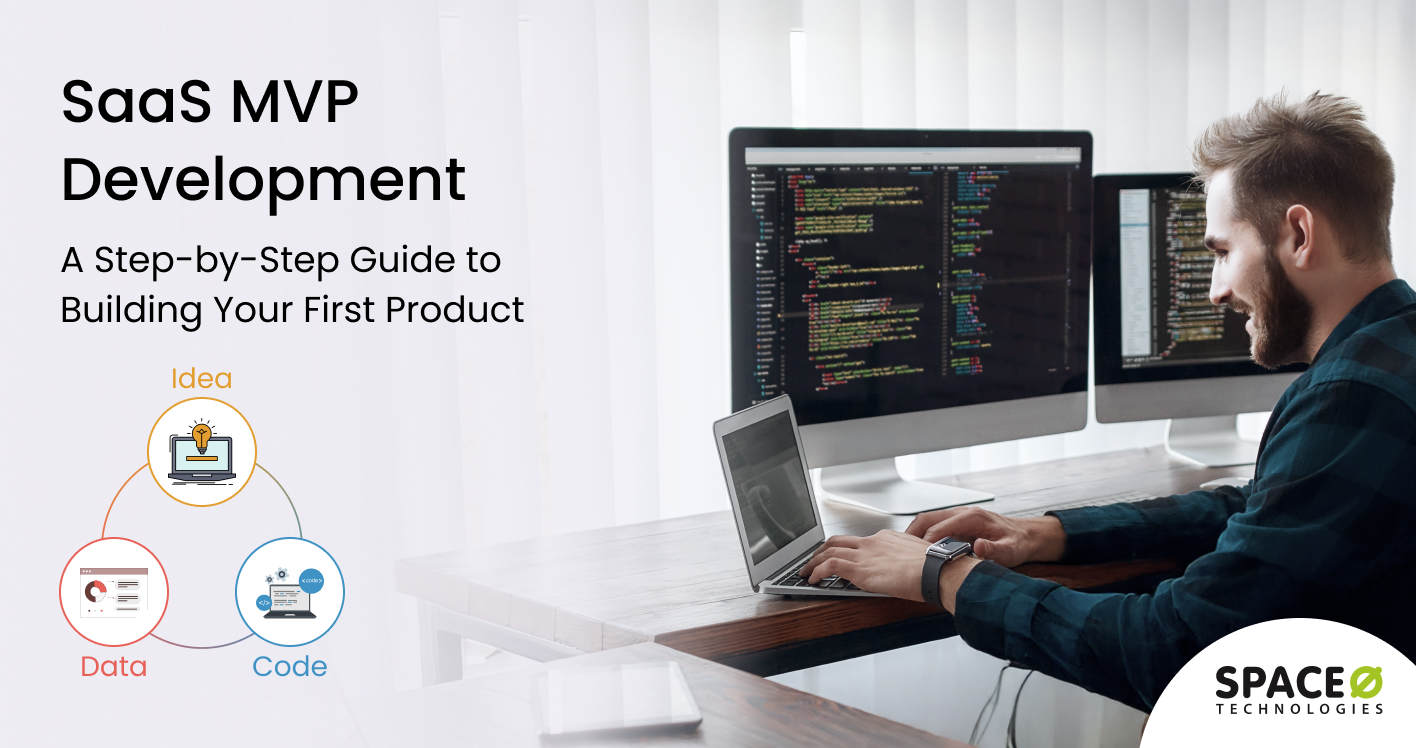Contents
Imagine spending months building your dream SaaS product only to realize no one wants it. Frustrating, right? Unfortunately, this happens more often than you think. Many startups invest heavily in development before testing whether their product solves a real-world problem.
So, the question directly hits up: How can we avoid these costly mistakes?
The simple and quick answer starts with a Minimum Viable Product (MVP). An MVP helps you launch a simplified version of your SaaS product, test its viability, and refine it based on real-world feedback—without breaking the bank.
But how do you build an effective SaaS MVP? That’s exactly what this guide will help you with. However, if you’re looking for the right team to bring your SaaS product to life, check out this list of top SaaS development companies to find expert partners to accelerate your journey.
Before diving into the development process, let’s first understand what an MVP for SaaS is and why it’s essential for your product’s success.
What is an MVP for SaaS?
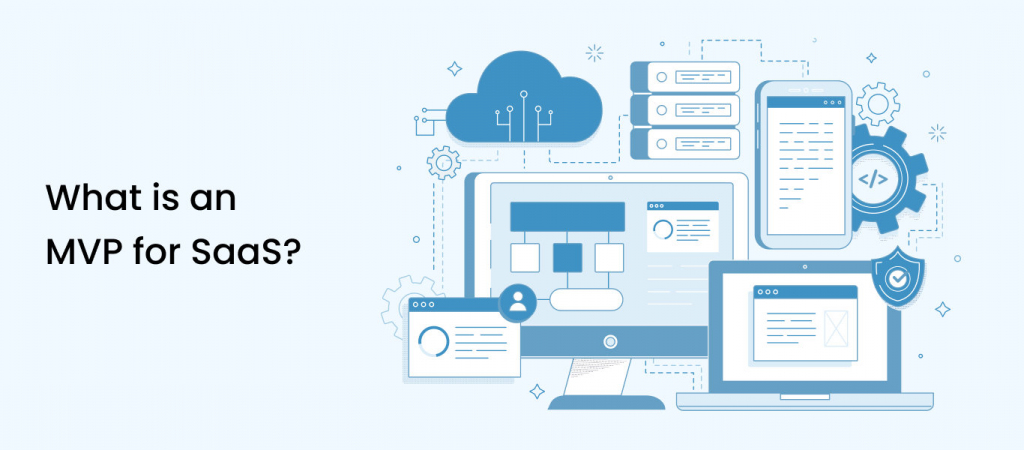
A Minimum Viable Product (MVP) for Software-as-a-Service (SaaS) is a basic yet functional version of cloud-based software that includes only the core features necessary to address the primary problem it aims to solve. The goal is to validate the idea, test market demand, and gather real user feedback before investing in full-scale development.
With more companies across industries—healthcare, finance, retail, education, and logistics—moving toward SaaS, the demand for streamlined operations and reduced infrastructure costs is at an all-time high. This shift is fueling massive market growth.
According to Precedence Research, the global SaaS market is projected to grow from $276.11 billion in 2022 to $1,016.44 billion by 2032. Launching a well-planned product has become essential as more businesses invest in SaaS solutions. Let’s quickly examine the benefits of building a SaaS MVP.
Benefits of building a SaaS MVP
Launching an MVP before full-scale development offers multiple advantages, such as reducing risks, saving costs, and accelerating time to market. Here’s how a SaaS MVP benefits startups and businesses:
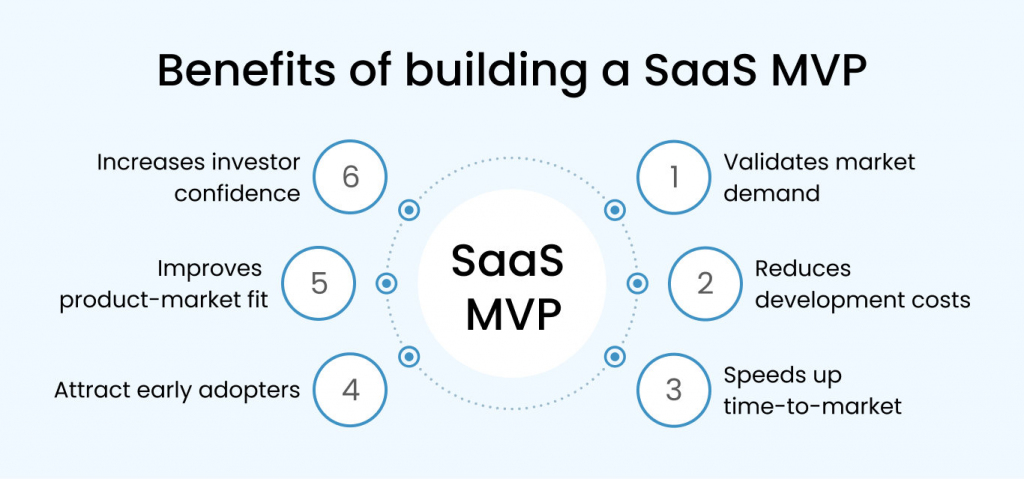
Validates market demand
An MVP helps determine whether there’s genuine interest in your product before you invest heavily in development. By releasing a simplified version, you can gather real user feedback and assess market potential early on.
Reduces development costs
Focusing on core functionalities minimizes unnecessary expenses during the initial build. Instead of developing complex features upfront, you can allocate resources strategically and scale based on user feedback.
Speeds up time-to-market
By prioritizing essential features, you can launch your product faster and start engaging with early users. This gives you a competitive edge by entering the market sooner while refining your solution over time.
Attract early adopters
Launching an MVP allows you to engage users who are willing to try new solutions and provide insights. Their feedback helps shape your product and ensures its evolution in the right direction.
Improves product-market fit
Real-world testing helps identify gaps between your solution and user expectations. You can refine the product based on actual usage data to align with market needs better.
Increases investor confidence
A functional MVP demonstrates your product’s potential and scalability to investors. Showing traction and real user engagement improves your chances of securing funding for further development.
Ultimately, a SaaS MVP helps you test, validate, and refine your product efficiently while minimizing risks. However, building an effective MVP requires careful planning and execution. Partnering with top MVP development companies ensures a strategic approach to building a scalable and market-ready SaaS product.
Build Your SaaS MVP in Just 3 Weeks
Let our SaaS architects build a reliable, user-friendly, and market-ready MVP that fits your business goals.

A Step-by-Step Guide to Building a SaaS MVP
Building a Minimum Viable Product (MVP) for your Software-as-a-Service (SaaS) business is a strategic approach to validating your idea, reducing risks, and accelerating market entry. A well-executed SaaS MVP focuses on core functionality and balances cost-effectiveness with value delivery. This guide walks you through the essential steps to building a high-impact SaaS MVP.
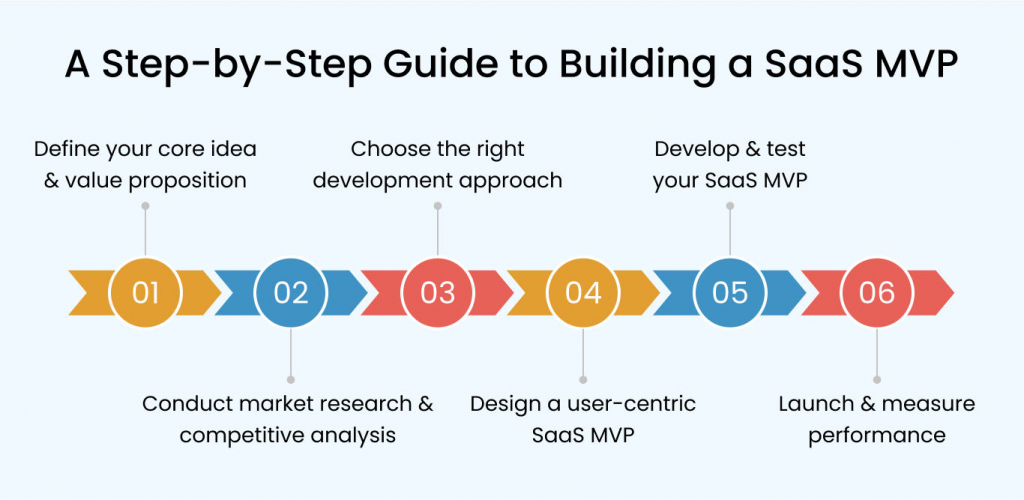
Define your core idea & value proposition
Before jumping into the SaaS MVP development process, clearly define your SaaS MVP’s purpose. Ask yourself:
- What problem does it solve?
- Who is the target audience?
- What core feature will differentiate it from existing solutions?
Your value proposition should be compelling enough to attract early adopters. Keep it simple—focus on solving a specific pain point rather than overloading your MVP with features. A well-defined idea sets the foundation for a successful SaaS product.
Additionally, consider conducting a SWOT (Strengths, Weaknesses, Opportunities, Threats) analysis to refine your idea. Identifying potential risks and barriers early on helps mitigate future challenges. Work on an elevator pitch that clearly articulates your product’s unique benefits concisely and persuasively. Understanding the global SaaS market and identifying trends will help shape your business model effectively.
Conduct market research & competitive analysis
Understanding the SaaS market helps you avoid costly mistakes. Conduct thorough market research to:
- Identify customer pain points and needs
- Analyze competitors’ strengths and weaknesses
- Assess market demand for your SaaS solution
Gather valuable insights through surveys, interviews, and competitor audits. Analyzing pricing models, feature gaps, and user reviews will help you refine your MVP concept and position it strategically.
Thorough market research should also include identifying a detailed customer persona. Define key user demographics, behavior, pain points, and expectations. Use tools like Google Trends, social media listening, and industry reports to gain deeper insights. A well-researched market analysis clarifies whether your idea has a viable audience and how you can position it uniquely in the competitive SaaS market.
Choose the right development approach
Selecting the right development approach depends on your budget, timeline, and technical expertise. Consider:
- No-code/low-code platforms: Ideal for non-technical founders who want a quick launch.
- Outsourcing SaaS MVP development services: Cost-effective if you lack in-house expertise.
- In-house development: This is best for long-term scalability and control.
Additionally, based on scalability needs, decide whether to use a monolithic or microservices architecture. A well-chosen approach ensures faster development without compromising quality.
Determining the best tech stack for your SaaS minimum viable product is also crucial. Consider using cloud computing platforms like AWS, Google Cloud, or Azure for scalability. If security and data protection are critical (e.g., in FinTech or healthcare applications), choose programming languages and frameworks based on your development team’s expertise and the nature of your SaaS product.
Ensure compliance with relevant regulations (e.g., GDPR, HIPAA). Effective project management is key in keeping the development cycle streamlined and efficient.
Design a user-centric SaaS MVP
A seamless user experience (UX) can make or break your MVP for SaaS. Prioritize:
- Intuitive UI/UX – Keep navigation simple and user-friendly.
- Essential features only – Prioritizing core functionalities that address the primary problem.
- Scalable architecture considerations – Design a foundation that supports future iterations.
Wireframing and prototyping tools like Figma or Sketch can help visualize the product before development, reducing rework and development time.
Conduct usability testing sessions with real users before finalizing your MVP’s design to enhance usability. Ensure mobile responsiveness and accessibility compliance (e.g., WCAG standards). A clean and minimalistic design increases user adoption and satisfaction. The more complex the platform, the higher its development and maintenance costs. Therefore, balancing essential functionality with scalability is key.
Develop & test your SaaS MVP
With a design blueprint in place, move into development. Follow these best practices:
- Agile methodology – Build in iterative cycles for flexibility and quick improvements.
- MVP tech stack selection – Choose reliable, scalable technologies that suit your product needs.
- Quality assurance (QA) testing – Conduct functional, performance, and security testing to detect bugs early.
A robust testing phase ensures a smoother launch, reducing post-release issues that could affect user retention.
Consider implementing automated testing tools to streamline the QA process. Before a full rollout, use unit testing, integration testing, and beta testing with a small group of users. If your SaaS software handles sensitive data, perform penetration testing to identify security vulnerabilities. Third-party services can also help optimize performance and security testing during development.
Launch & measure performance
Your MVP’s success depends on how effectively you introduce it to the market and gather user feedback. Steps to follow:
- Soft launch or beta testing – Release to a limited audience for real-world testing.
- Gather user feedback – Use analytics, surveys, and direct interactions to understand user needs.
- Iterate based on insights – Prioritize feature updates and improvements based on user behavior.
Key performance indicators (KPIs) such as customer acquisition cost (CAC), churn rate, and user engagement metrics help measure success and guide future development.
Additionally, to increase visibility, consider leveraging digital marketing strategies such as content marketing, PPC campaigns, and social media outreach. A strong customer relationship management (CRM) system, including chatbots or dedicated support teams, can help early adopters navigate the product and provide valuable feedback. SaaS companies that build a strong feedback loop early on gain valuable insights that drive product improvements and a well-defined monetization strategy.
Validate Your SaaS Product Idea with a High-Impact MVP
Get a market-ready SaaS MVP in weeks—not months. Work with our expert developers to confidently launch, validate, and scale.
Developing a SaaS application involves validating your idea with minimal investment while ensuring maximum learning. Following these steps, you can efficiently create a product that meets market demands, attracts early adopters, and prepares for full-scale development. The key is to remain agile, data-driven, and user-focused throughout the product development.
How Much Does SaaS MVP Development Cost?
Building SaaS MVP is crucial for startups to validate their business ideas. This blog provides an in-depth guide on MVP development for startups, helping readers understand its importance and strategy.
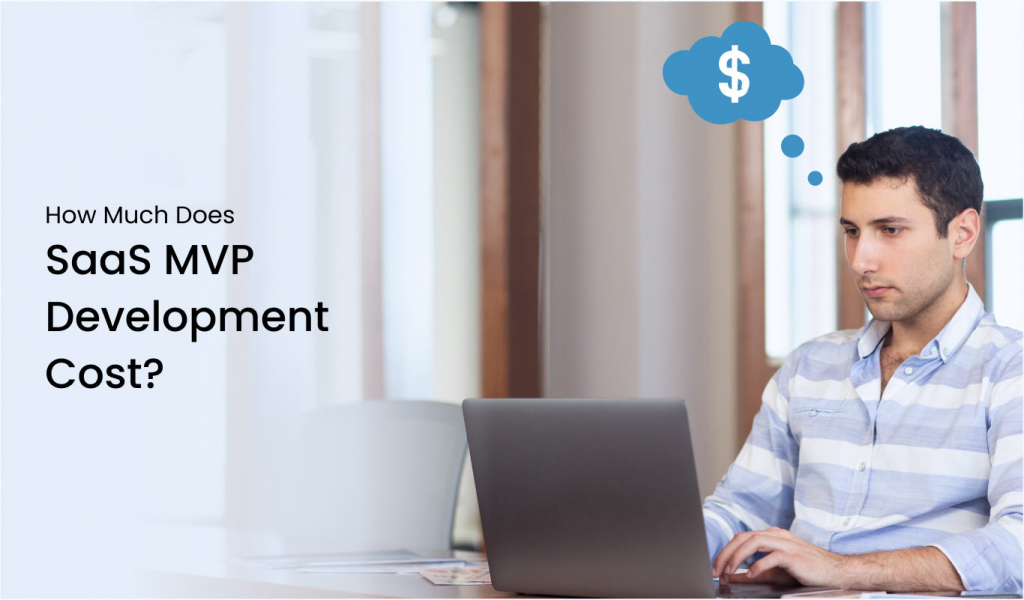
After discussing with industry experts and analyzing multiple projects, we have identified key cost components involved in MVP SaaS development. The following SaaS MVP cost breakdown outlines the estimated expenses for each stage.
| SaaS MVP Stage | Estimated Cost Range | Description |
|---|---|---|
| UI/UX Design | $5,000 – $30,000 | A well-structured, user-friendly interface improves engagement and usability. This includes wireframing, prototyping, and responsive design to enhance the user experience. |
| Backend & Frontend Development | $15,000 – $80,000 | The core development process involves building a scalable backend and interactive frontend using suitable frameworks, databases, and cloud technologies. |
| Cloud Hosting & Infrastructure | $1,000 – $10,000 | Cloud services like AWS, Google Cloud, or Azure provide storage, processing power, and security for seamless SaaS application performance. |
| Third-Party Integrations | $3,000 – $15,000 | APIs for payment gateways, analytics, authentication, and CRM tools enhance functionality without building features from scratch. |
| Security & Compliance | $2,000 – $10,000 | Implementing encryption, data protection, and regulatory compliance (GDPR, HIPAA) ensures security and user trust. |
| Testing & Quality Assurance | $5,000 – $20,000 | Functional, performance, and security testing help detect bugs, optimize performance, and ensure a seamless user experience. |
| Maintenance & Support (Annually) | $5,000 – $15,000 | Ongoing updates, bug fixes, server monitoring, and feature enhancements keep the SaaS platform stable and up to date. |
These are the key cost associated with SaaS mvp development. However, if you are looking for detailed cost, we have written a complete guide cost for developing an MVP that discusses the factors, tips and hidden cost involved in development.
4 Major factors influencing SaaS MVP development costs
Developing a SaaS Minimum Viable Product (MVP) involves multiple cost-driving factors that vary based on the business model, technology stack, and long-term scalability. Making the right choices in these areas ensures a cost-efficient app development process while delivering a high-quality, market-ready product.
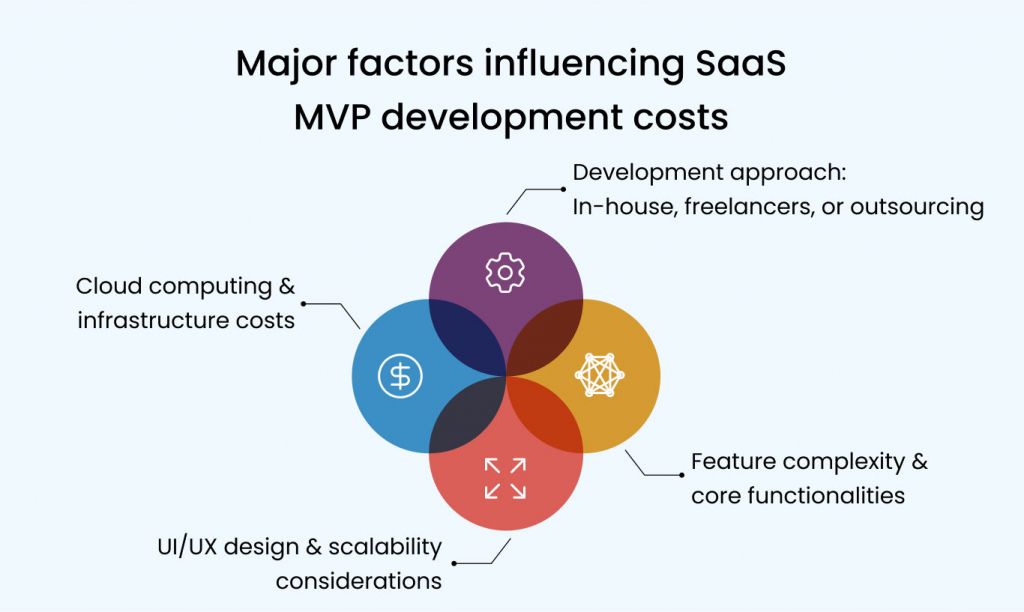
Development approach: In-house, freelancers, or outsourcing
The choice of a development team plays a crucial role in determining the overall budget, time to market, and product quality. Each approach has its benefits and cost implications:
- In-House Team: Hiring dedicated developers, UI/UX designers, QA testers, and project managers can be a long-term investment, but it comes with higher upfront costs. Salaries, benefits, infrastructure, and software licenses can total $100,000–$300,000+ annually.
- Freelancers: Hiring independent developers may cost $10,000–$50,000, but quality and timelines vary. Addressing customer feedback and implementing necessary updates can be challenging without a structured development process.
- Outsourcing SaaS MVP Development Services: Collaborating with an experienced SaaS MVP development service provider offers a balance between cost and expertise. Depending on project scope, complexity, and location, outsourcing typically costs between $25,000 and $150,000.
Feature complexity & core functionalities
The cost of MVP SaaS development is directly influenced by feature complexity and the number of functionalities included in the initial release. A lean MVP focuses on solving user pain points with key features, keeping development costs lower.
- User Authentication & Authorization: Secure login and account management
- Admin Dashboard & Analytics: Monitoring usage patterns and system performance
- Payment Integration: Subscription-based billing, invoicing, and refunds
- Role-Based Access Control: Defining user permissions within the SaaS platform
- Third-Party Services & API Integrations: Connecting with external tools like CRM, automation software, and cloud storage solutions
UI/UX design & scalability considerations
A seamless, intuitive user experience (UX) is essential for customer retention and engagement. Poorly designed SaaS platforms often experience high churn rates, so UI/UX investment is a priority.
- Essential UI/UX Design: Wireframing, user flows, and responsive design: $5,000–$15,000
- Custom UI Elements & Animations: Advanced interactive designs: $15,000–$30,000
- Usability Testing & Iterations: A/B testing and feedback implementation: $3,000–$10,000
Additionally, scalable architecture ensures the product can handle growing user traffic and data loads without requiring a significant rebuild.
Cloud computing & infrastructure costs
Hosting a SaaS software requires a reliable cloud infrastructure, which incurs recurring costs based on usage, data storage, and computing power. Common expenses include:
- Basic Cloud Hosting (AWS, Google Cloud, or Azure): $100–$500 per month
- Database & Storage Costs (MySQL, PostgreSQL, Firebase): $200–$1,000 per month
- Third-Party Services & API Integrations (payment gateways, AI tools, analytics): $500–$3,000 per month
- Security & Compliance Expenses (SSL certificates, encryption, GDPR/HIPAA compliance): $2,000–$10,000+ annually
Understanding these cost factors allows SaaS startups to prioritize features, optimize development expenses, and build a scalable, high-performing SaaS MVP. Whether you outsource development, hire an in-house team, or leverage cloud-based solutions, planning and allocating resources efficiently can help control costs while ensuring a competitive and successful launch.
5 Benefits of SaaS MVP Development for Startups
Building a SaaS Minimum Viable Product (MVP) is a strategic approach that helps startups validate ideas, attract investors, and optimize development costs. Here’s how an MVP benefits your SaaS business:
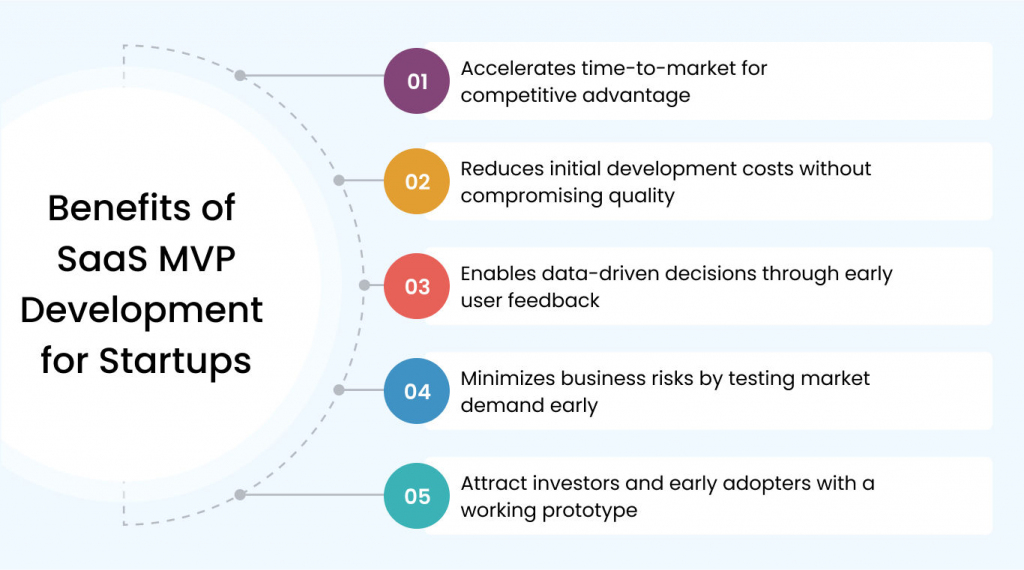
Accelerates time-to-market for competitive advantage
Launching an MVP allows startups to enter the market faster, focusing on core functionalities rather than a fully developed product. This speed gives an early-mover advantage, helping startups gain initial traction, collect user data, and refine their product before competitors catch up.
Reduces initial development costs without compromising quality
Developing an MVP minimizes upfront costs by focusing only on essential features. Instead of investing heavily in a full-fledged SaaS solution, startups allocate resources efficiently, ensuring quality development while staying within budget. This lean approach prevents wasted time and expenses on unnecessary features.
Enables data-driven decisions through early user feedback
An MVP helps gather real-world user feedback to understand customer pain points and feature preferences. By analyzing user behavior, engagement, and requests, startups can make data-driven improvements rather than relying on assumptions. This iterative development approach leads to a more user-centric SaaS product.
Minimizes business risks by testing market demand early
Instead of assuming market needs, an MVP provides a real-world validation of your SaaS idea. Early adopters test the product, and their responses determine whether the solution is viable, scalable, or needs adjustments. This reduces financial risks and prevents costly failures by ensuring genuine demand before scaling.
Attract investors and early adopters with a working prototype
A well-executed MVP serves as a functional proof of concept, making it easier to secure funding from investors. Instead of presenting an idea, startups can showcase a working product with real users and data, increasing their credibility and chances of securing investment. Additionally, early adopters who find value in the MVP can become brand advocates, helping with organic growth.
3 Major Challenges in SaaS MVP Development & Their Solutions
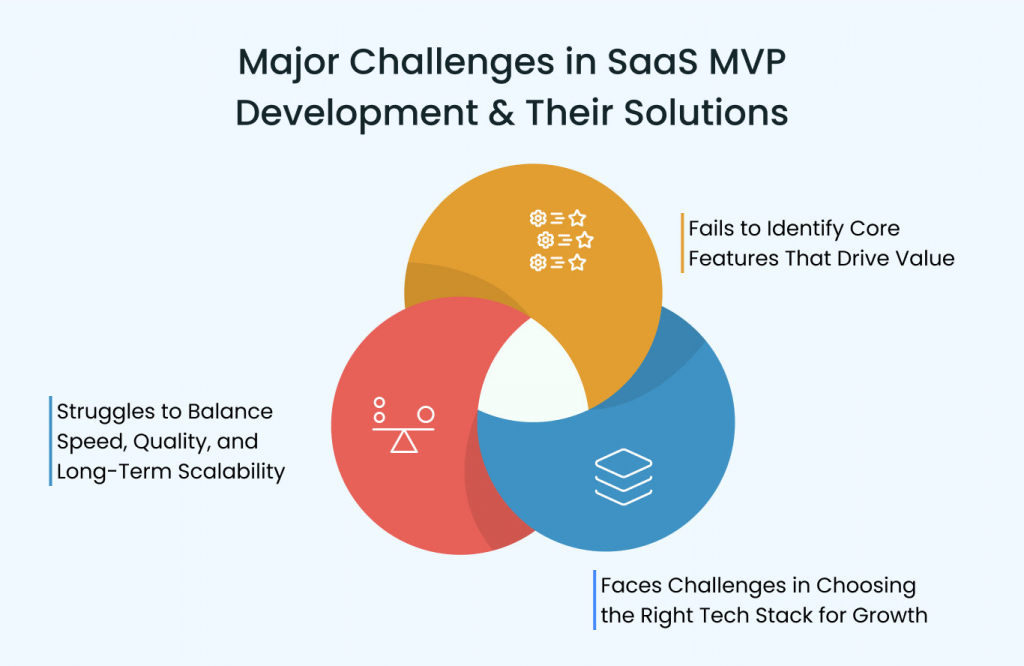
| Challenge | Explanation | Solution |
|---|---|---|
| Fails to Identify Core Features That Drive Value | Startups often struggle to determine which key features should be included in the MVP. Adding too many features increases costs and delays launch while excluding critical functionalities can lead to poor adoption. | Focus on the most pressing user pain points using a problem-first approach. Use the MoSCoW method to prioritize features. Gather customer feedback through surveys and competitor analysis to refine the MVP’s core functionalities. |
| Faces Challenges in Choosing the Right Tech Stack for Growth | Selecting the wrong technology stack can cause performance bottlenecks, integration issues, and scalability limitations. Quick-fix solutions may work initially but create problems when scaling. Outdated or incompatible tech increases maintenance costs and security risks. | Choose a scalable architecture with cloud-based solutions like AWS, Google Cloud, or Azure. Select technologies based on long-term scalability, security, and integration ease. Consulting SaaS MVP development services ensures informed decisions. |
| Struggles to Balance Speed, Quality, and Long-Term Scalability | Startups often rush their MVP to market, compromising code quality, security, and user experience. A poorly optimized product leads to negative customer feedback and high churn rates, while over-engineering delays market entry and inflates costs. | Adopt an agile development approach with short sprints to ensure rapid iteration. Conduct performance testing, security checks, and usability assessments at each stage. Use customer feedback to refine the product post-launch and build a scalable architecture from the beginning. |
Build a Feature-Driven MVP That Sells
Too many or too few features? We help you strike the perfect balance—delivering an MVP that solves real problems and wins customers.
Developing a SaaS Minimum Viable Product (MVP) is a strategic yet complex process that comes with several challenges. Failing to address these obstacles can lead to wasted resources, slow adoption, or scalability issues. Here’s a look at three key challenges and their practical solutions.
Take the Right Steps Toward a Successful SaaS MVP
SaaS MVPs start with a clear vision and a focus on solving real user problems. Identify the core issue your product addresses and define a unique value proposition that sets it apart. Keep your feature set minimal—only what’s essential to validate your idea and deliver immediate value.
Execution matters. Choose a scalable tech stack, develop with an agile mindset, and gather continuous user feedback to refine your product. Testing and validation are crucial—launch a beta version, analyze user behavior, and make data-driven improvements to ensure market fit.
Success isn’t just about launching—it’s about preparing for growth. A strong MVP lays the foundation for scalability and long-term success. Space-O Technologies specializes in SaaS MVP development services, helping businesses launch confidently. Let’s build something impactful together.
FAQs About SaaS MVP Development
How long does it take to develop a SaaS MVP?
The development timeline for a SaaS MVP typically ranges from 3 to 6 months, depending on the project’s complexity, features, and development approach. A lean MVP with essential functionalities can be built in 8 to 12 weeks, while a more feature-rich solution may take longer.
Should I hire an in-house team or outsource SaaS MVP development?
Choosing an in-house team or outsourcing depends on budget, expertise, and time constraints. Hiring an in-house team provides full control over the development process but involves higher recruitment, salaries, and infrastructure costs. Outsourcing to a specialized SaaS development company offers access to experienced developers, faster turnaround, and cost savings. Businesses looking for scalability, flexibility, and reduced overhead often find outsourcing a more viable option.
Which technologies are best for developing a SaaS MVP?
The ideal tech stack for a SaaS MVP depends on project requirements, scalability, and security. Common choices include:
- Frontend: React, Angular, Vue.js
- Backend: Node.js, Python (Django, Flask), Ruby on Rails
- Database: PostgreSQL, MongoDB, Firebase
- Cloud Services: AWS, Google Cloud, Azure
- DevOps & Deployment: Docker, Kubernetes, CI/CD pipelines
- Choosing a stack that balances performance, security, and scalability is key to long-term success.
How do I validate my SaaS MVP idea before launch?
Validating a SaaS MVP involves ensuring market demand and product-market fit before investing heavily in development. Key validation steps include:
- Customer Interviews & Surveys: Understand user pain points and needs.
- Landing Pages & Pre-Signups: Test interest through waiting lists or pre-orders.
- Prototyping & Wireframes: Share clickable demos with potential users for feedback.
- Competitor Analysis: Identify gaps in the market and potential differentiation.
- Beta Testing & Early Adopters: Release an initial version to a limited audience for real-world validation.
Can I build a SaaS MVP without coding skills?
A SaaS MVP can be built without coding skills using no-code and low-code platforms. Tools like Bubble, Adalo, Webflow, and OutSystems allow entrepreneurs to create functional prototypes and launch MVPs without writing code. However, hiring experienced developers or partnering with a development agency is often necessary for a scalable and feature-rich SaaS product.
What mistakes do SaaS startups make when developing an MVP?
SaaS startups often make the following mistakes when developing an MVP. Avoiding these mistakes helps reduce development costs, speed up time-to-market, and improve product success.
- Building Too Many Features: Overcomplicating the MVP instead of focusing on core functionality.
- Skipping Market Research: Ignoring user needs and developing a product without demand validation.
- Choosing the Wrong Tech Stack: Selecting technologies that hinder scalability and performance.
- Ignoring User Feedback: Failing to iterate based on real-world usage and customer insights.
- Lack of a Go-to-Market Strategy: Developing an MVP without a solid launch and marketing plan.
